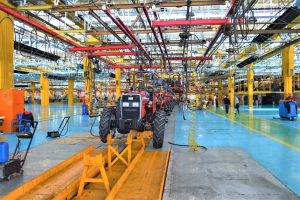8.2 Defining Sustainable Value Chain
Learning Objective
1. Define the term Sustainable Value Chain and how it adds value in the global value chain
Video: The Complex Path to Sustainability | Olivia Tyler | TED Institute (7:43)
Do you know where everything you buy comes from? Olivia Tyler illuminates the daunting challenges companies face when enforcing sustainability across their supply chains.
Media 8.5 The Complex Path to Sustainability | Olivia Tyler [Video]. TED Institute. (URL: https://www.youtube.com/watch?v=5lgxdOTIrCo)
When companies aim at minimizing the impact on the environment while benefiting the communities and the people, they address global issues and focus on Sustainable Value Chain. Sustainable value chain is a concept that focuses on global issues such as human rights, global warming and melting ice caps, fair labour practices, marine pollution, decreases of forest cover, plastic pollution, air pollution, etc. For example, many global values chain companies focus on the speed, delivery, cost, reliability, and quality of goods and operations. Still, only a few companies add strategic goals to consider global issues’ environmental and human impact. These strategic goals can be decreasing carbon emissions and improving labour conditions. There are many ways of reducing the impact on the environment: changing the liner business model towards sustainable, inclusive, and resilient value chains is vital nowadays. In addition, companies have to look at the source of materials and their impact on the earth. Sustainability is an opportunity for businesses, but it is hard to understand the global goals, trade, policies, and improving three main parts simultaneously: social, environmental, and economical. Moreover, the sustainable value chain is related to the core of the whole business, from the strategy to developing products and relationships.
Figure 8.1
Untitled Photo

Note. From LeBoutillier, 2021. Unsplash License.
Did You Know?
The following material adapted from “The Role of the Global Value Chain in Improving Trade and the Sustainable Competitive Advantage: Evidence From China’s Manufacturing Industry” by (Deqiang, Zhijun, Hajduk-Stelmachowicz, Larik, & Rafique, 2021) under a Creative Commons Attribution License 4.0.
In the domain of globalization, the global value chain (GVC) is formed across diverse economies. Owing to the expansion of economic globalization and the resultant global trade liberalization, the geographical isolation of production and consumption has resulted in the transfer of polluting emissions from advanced economies to developing states. Developing economies, falling in the middle and low end of the GVC, have to strive hard to expand their production in the GVC, while simultaneously addressing the consequent environmental damage and attending to the core environmental concerns of sustainable growth, energy preservation and drastic cuts in CO2.
China’s manufacturing industry addresses how manufacturing subsidiaries can improve their low-carbon innovation ability and help to achieve a sustainable competitive advantage through the embedded GVC. 31 manufacturing companies and 56 enterprise groups across 16 Chinese provinces were selected and studied. The results indicate that the embedded GVC significantly enhances low-carbon innovation capability and promotes a sustainable competitive advantage. Companies should continuously identify high-quality resources from the GVC and discover ways of integrating internal and external carbon innovation resources to form innovation capabilities.
Since the 1990s, the Chinese manufacturing sector, by virtue of trade and investment, has achieved tremendous milestones driven by the global manufacturing network. However, its further premium growth has been hampered by the resulting environmental degradation. The available data on environmental health reveal that around 70% of the global pollution is caused by the Chinese manufacturing sector, which produces nearly 700 million tons of environmentally damaging waste per annum. The Central Economic Working Conference, organized in 2014, suggested that the capability of China to pay due attention to the environment had been stretched to its limits and that it was high time to search for a model that was environmentally friendly and founded on preferences for low carbon. At present, the Chinese Organization of International Production has been overhauled and a gradual shift has been witnessed towards intra-product specialization that has transformed the manufacturing sector into a highly complex one. The upgrading of all the production processes to incorporate more advanced technology inevitably leads to a major increase in costs, despite the significant reduction in emissions. Since most enterprises are essentially profit-oriented, the pursuit of green technology in manufacturing processes is not of significant interest to them. Therefore, it is high time that the pace of the innovation factor input to output effect should be maximized, while CO2 emissions must be minimized.
The year 2018 marked the execution phase of “Made in China 2025” suggesting a win-win policy that simultaneously attends to the protection of the environment and also the development of the manufacturing sector. Currently, the Chinese manufacturing sector is under stress from both the domestic and international governments to limit the high-end of the value chain. The recent discourse argues that developing economies, especially China, should strive for knowledge spillovers employing the means of foreign direct investment (FDI), outward foreign direct investment (OFDI), and import and export trade that are all helpful for pro-green development. Under the “new normal” model, the Chinese economy should enhance the quality and sustainability of economic development in order to improve the total factor productivity employing GVC embeddedness. For sustainable economic development worldwide, the environmentally friendly growth path plays a key role in minimizing the greenhouse effect. However, most manufacturers seek to optimize their profits and are unwilling to manufacture low-carbon goods unless they are offered certain incentives. Apart from the concerns by consumers and firms on low-carbon goods, coordination plays a key role in the low-carbon supply chain production. The resource-based view (RBV) postulates that enterprises possess unique physical and intangible resources that may have exceptional potential to produce a sustainable competitive advantage. A few studies have shown that firms that are embedded in the GVC can gain new skills and obtain specialized knowledge.
This example provides sufficient evidence to support the notion that embedment in the GVC significantly enhances the low-carbon innovation capability through global cooperation. The authors noted that the successful embedment of global low-carbon R and D, manufacturing, and marketing led to an increase in the low-carbon innovation capabilities. Secondly, the results indicate that an improvement in the low-carbon innovation capability has a considerable impact on the fostering of a sustainable competitive advantage and support for low-carbon technology, system, capital, and management innovation capability. Thirdly, the results obtained in this study confirm that the low-carbon innovation capabilities significantly mediated the positive effect of embedment in the GVC on the sustainable competitive advantage of Chinese manufacturing subsidiaries. (Deqiang, Zhijun, Hajduk-Stelmachowicz, Larik, & Rafique, 2021).
Figure 8.2
Iran Tractor Factory
 Note. From Khorsand, 2019. Unsplash License.
Note. From Khorsand, 2019. Unsplash License.
This example also highlights some essential managerial implications that should be addressed. The manufacturing subsidiarie’s capability to achieve a sustainable competitive advantage represents a significant asset when developing innovations. The findings reveal that a thorough evaluation of the company’s innovation resources to identify potential positions for the GVC is highly advisable. Therefore, companies should continuously identify high-quality resources from the GVC and discover ways of integrating internal and external carbon innovation resources to form innovation capability. Besides, companies should also analyze the cost issues of transforming the low-carbon innovation capability into a competitive advantage and evaluate the consistency of their low-carbon innovation strategy with the parent company. The findings can be used to facilitate manufacturing subsidiaries in increasing their sustainable competitive advantage and consequently supporting their capability to utilize external knowledge and insights from embedment in the GVC. Hence, it is evident that low-carbon innovation resources play the role of a sustainable competitive advantage for manufacturing subsidiaries.
(Deqiang, Zhijun, Hajduk-Stelmachowicz, Larik, & Rafique, 2021) CC-BY-4.0
Check Your Understanding
Define the term Sustainable Value Chain and how it adds value in the global value chain.
Answer the question(s) below to see how well you understand the topics covered above. You can retake it an unlimited number of times.
Use this quiz to check your understanding and decide whether to (1) study the previous section further or (2) move on to the next section.
Interactive activity unavailable in this format
Text-based alternative to interactive activity to interactive activity available in Chapter 8.8.
Overall Activity Feedback
When companies consider goals related to minimizing the impact on the environment while benefiting the communities and the people, this means that this company addresses global issues and focuses on a Sustainable Value Chain. The sustainable value chain focuses on global issues such as human rights, global warming and melting ice caps, fair labour practices, marine pollution, decreases of forest cover, plastic pollution, air pollution, etc. The main dimensions of suitability in the global value chain are environmental, economic, and social dimensions. Integration of three dimensions, economic, social, and environmental. Companies should continuously identify high-quality resources from the GVC and discover ways of integrating internal and external carbon innovation resources to form innovation capability. Besides, companies should also analyze the cost issues of transforming the low-carbon innovation capability into a competitive advantage and evaluate the consistency of their low-carbon innovation strategy with the parent company.
Media Attributions and References
Amin Khorsand. (2019, August 27). Iran tractor factory [Photograph]. Unsplash. https://unsplash.com/photos/tAnzPbVXjQo
LeBoutiller, C. (2021, January 21). Untitled photo [Photograph]. Unsplash. https://unsplash.com/photos/TUJud0AWAPI
TED Institute. (2018, February 15). The complex path to sustainability | Olivia Tyler. [Video]. YouTube. https://www.youtube.com/watch?v=5lgxdOTIrCo

